
Types of dental crowns: here are the 5 main models
Many patients have doubts about the types of dental crowns that exist and their differences. This article has been prepared to educate you. This way, you’ll know the characteristics of all the types of dental crowns available here at the ImplArt Dental Clinic, located at São Paulo-Brazil, always knowing that the most up-to-date technology in the world is here!
Did you know that there are different types of dental crowns?
They differ from the point of view of execution, whether computerized or traditional, as well as the aesthetic refinement they achieve. They can be used both on dental implants and on tooth roots. Some are made using exclusively digital molding, while others still use the old mass molding.
A good indication for people who need to rebuild their teeth and make their aesthetics uniform are porcelain dental crowns or zirconia crowns, which restore the natural appearance and make the smile complete.
Follow us in this article to learn how to differentiate between the types of crowns and choose the one that best suits what you’re looking for as a final result.
What are dental crowns for and what are their types and indications?
The purpose of a dental crown is above all to restore the shape and functionality of the tooth. In short, it is a prosthetic piece (artificial tooth) with the shape and function of a natural tooth. There are a few types of dental crowns that can be selected for your treatment.
The choice of material will depend on a conversation between the dental specialist (prosthodontist) and the patient, which mainly aims to clarify the purpose of the dental crown (aesthetics vs. strength), and the expected durability (temporary vs. permanent).
Dental crowns can be placed on tooth roots with or without a treated root canal, and can also be made for dental implants. Dental crowns can be individual or, if the space is large, crowns can be joined with pontics (suspended teeth), thus creating a fixed dental prosthesis.
In which cases might I need porcelain dental crowns?
Other indications for dental crowns include:
- Protecting a tooth weakened by fractures
- Restoring a damaged tooth
- Part of other larger dental prostheses
- Restoring a dental implant,
- Recovering a badly stained or deformed tooth
- Recovering a tooth with root canal treatment
What are the types of materials for porcelain dental crowns and what are their differences?
In the past there were other types of dental crowns that we now consider outdated, such as all-metal crowns, gold crowns, resin veneer crowns or porcelain veneer crowns with metal, as well as procera crowns, alumina crowns, inceram crowns, empress crowns, pivots and jackets.
We will therefore present the 4 most modern materials with which we currently make dental crowns in our clinic. In other words, we classify Pure Zirconia as the most modern, followed by Pure Porcelain, both made using computerized systems. In second place are the handmade crowns, called applied zirconia and metal-ceramic.

Types of dental crown and their technical differences. All these types of dental crowns are available at our dental clinic and laboratory. * The technical name refers to the type of porcelain used in the dental crown. ** The strength of porcelain crowns is measured according to the ISO technical standard for flexural strength, measured in MPa. Estimate of aesthetics and durability express the opinion of the author of this article. In the case of MC and ZC crowns, the strength of the structure is high, around 1000 MPa, but problems occur because the thin layer of more fragile porcelain stands out.
Classification of different types of crown based on manufacturing technique:
Below you’ll find different types of dental crowns, classified according to the material they’re made from and how they’re made.
Dental crowns made using computerized techniques and artificial intelligence:
- 3D Zirconia dental crown – computerized solid translucent zirconia
- EMAX 3D Pure Porcelain Crown – computerized solid lithium disilicate
Porcelain crowns made using conventional handcrafted techniques:
- Metal-porcelain crown (metal-ceramic) – This has a thin layer of metal and the porcelain is applied by hand.
- Zirconia-porcelain crowns (applied zirconia) – These have a thin layer of zirconia reinforcement and the porcelain layer is applied by hand.
Crowns in new composite materials, which are computerized but not pure porcelain:
- 3D Printed Crown (Computerized Resin) – Material containing resin+porcelain
- Resin-milled crown – PMMA made by 3D milling machine
These new composite materials have lower strength than traditional porcelain crowns. However, they look good and can be used in some cases as long-term provisionals or even as permanent crowns.
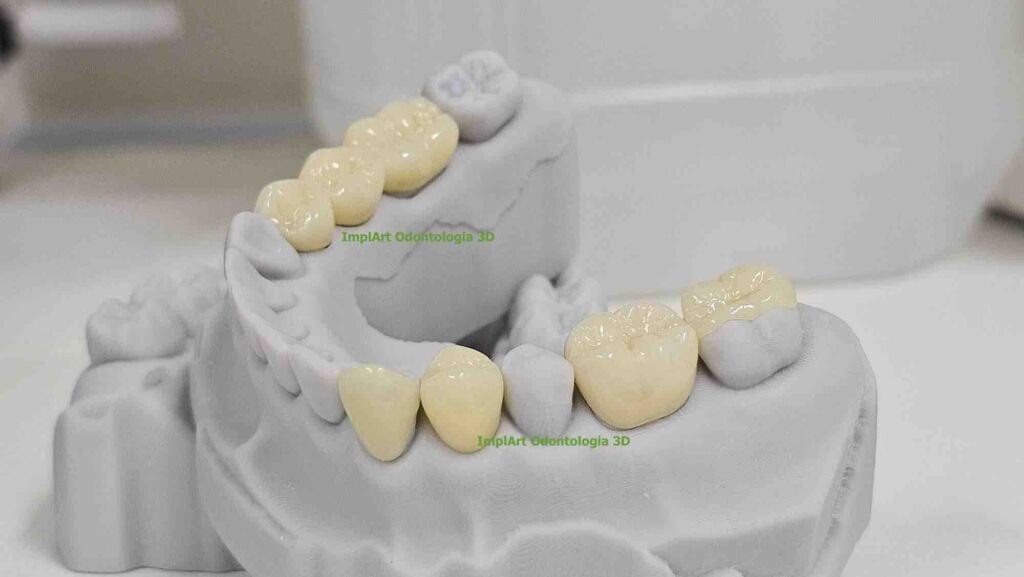
The porcelain crown remains the best material and can be made using different techniques
Please note that the term porcelain crown is a generic term but can have subtypes. The correct selection of the crown material has a major impact on the final result, how it is made and even on the budget
Learn more about the types of dental crowns and choose the best one for you
For example, we have the modern 3D Zirconia dental crown, which is made using modern computerized planning resources and 3D milling machines. In addition to this crown, there is the EMAX Pure Porcelain Crown. Both crowns provide excellent aesthetic resultsin short periods of time. This allows the patient to enjoy the results achieved more quickly.
Dental materials differ in the way they are prepared clinically and in the laboratory, as well as in their aesthetic results and degrees of resistance.
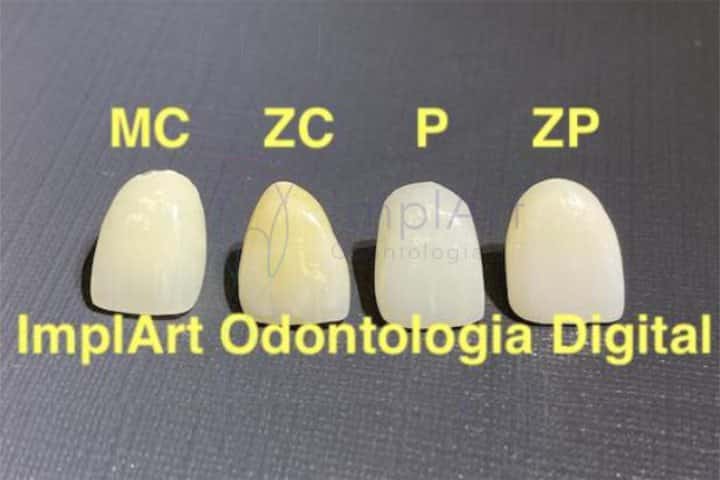
Porcelain + metal dental crown (metal ceramic is porcelain applied by hand to metal) – MC
Porcelain applied over metal (metal-ceramic) is an old technique for making dental crowns, and it’s also the one that ends up having the lowest final value for the patient and the lowest manufacturing cost for the dentist (see photos of the MC crown). Even though they are not as aesthetic as porcelain crowns without metal, metal-ceramic crowns are still used to restore teeth in the back of the mouth.
All metal-ceramic crowns have a structural underlying metal layer and then the porcelain/ceramic on top of it. The metal structure is thin, strong and fits perfectly on the prepared teeth. A layer of porcelain is applied over the metal structure (called a coping). The porcelain layer is 1.5 mm to 2 mm thick, depending on the area of your tooth.
The porcelain layer is resistant, withstands chewing forces very well and resembles natural teeth. However, metal-free porcelain crowns are the most widely used today, as they easily match the color of adjacent teeth better than metal-ceramic crowns. Metal-ceramic crowns are more opaque and not as natural-looking as today’s best dental crowns.
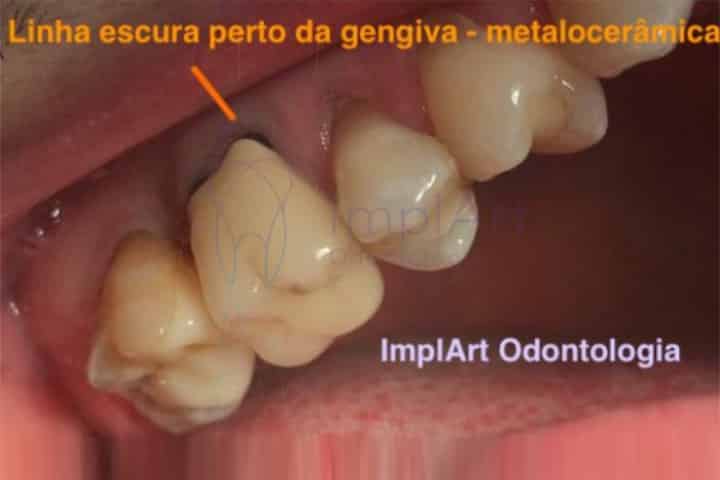
In some cases, porcelain on metal wears, chips, cracks or breaks over time, exposing the metal and making the work unsightly and non-functional. In addition, in cases of gum recession, dark lines may appear near the gums or parts of the metal.
Because of these limitations, metal-ceramic crowns are more suitable for back teeth and should not be used on front teeth. Other disadvantages of metal-ceramic crowns include the possibility of causing allergies and gum irritation.
Zirconia + porcelain dental crowns (zirconia with hand-applied ceramic) – ZC
A zirconia crown with porcelain applied is similar to a metal-ceramic crown in the way it is made. A crown with a zirconia structure also has 2 layers, but instead of metal, we have dental zirconia, a very resistant white material. You can see the two layers of material in the dental crown in the photo below.
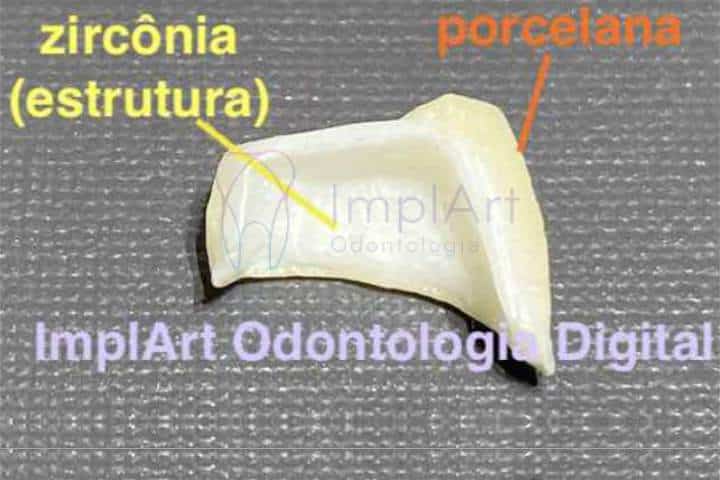
Zirconia is considered to be an artificial diamond and is as resistant as a metal. In fact, dental zirconia has properties similar to metals, with the advantage of being white and therefore more aesthetic. The composition of zirconia crowns + applied porcelain does not include metal, improving the aesthetic results.
The zirconia dental crown with porcelain is also suitable for replacing a large restoration when the tooth structure has deteriorated.
| Type of Dental Crown | Materials | Indications | Main Features |
|---|---|---|---|
| Emax Computerized Porcelain Crown | Lithium disilicate | Anterior and Posterior Teeth | Superior aesthetics, similar to the natural color of the teeth – Fast preparation |
| Porcelain crown with metal base (Metaloceramic) | Porcelain, Metal | Posterior Teeth | Functional and sturdy but poor aesthetics – Slow to produce |
| Zirconia crown with ceramic application | Ceramic, Zirconia | Anterior and Posterior Teeth | High resistance, aesthetics and biocompatibility – Slow production |
| Translucent 3D Pure Zirconia Crown | Zirconia | Anterior and Posterior Teeth | High resistance, aesthetics and biocompatibility – Rapid production |
| Resin crown | Acrylic resin | Anterior Teeth | More economical alternative, but less resistant than other materials. |
| Metal crown | Metal (Precious Metal Alloy/Gold) | Posterior Teeth | Good resistance, especially in areas of high masticatory load. poor aesthetics. |
| Temporary crown | Acrylic or Temporary Resin | Provisional phase before Permanent | Temporary use during treatment or until the permanent crown is made. |
CAD-CAM pure porcelain dental crown (Emax – lithium disilicate) – P
Pure porcelain crowns – the EMAX system – are made using the CAD-CAM (Computer Assisted Design) technique for the computerized production of special porcelain crowns and restorations. They are therefore highly translucent and resistant. Their long-lasting and highly aesthetic results enable excellent results to be achieved quickly. These are the main properties of an Emax crown, which make them one of the best options for restoring front teeth.
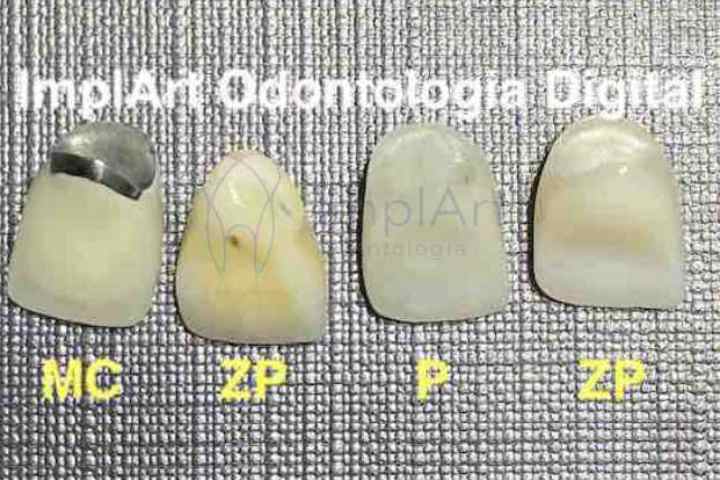
Emax all-ceramic dental prostheses and crowns are rapidly gaining popularity in aesthetic dentistry due to their excellent aesthetics, durability and strength. The Emax system is mainly suitable for the fabrication of crowns and dental contact lenses in the anterior region. After preparing the final tooth shape, a digital mold of your teeth will be made with an intraoral camera.
This mold is then transmitted via the internet to the computer in our dental laboratory, which controls the design and milling procedure. The color of the dental crown needs to be chosen in advance to resemble natural teeth. With the design approved, a milling machine cuts the monolithic block of lithium disilicate to produce the required shape of the prosthesis, already with the right color.
As the crown is made from a single block of material and has a single layer, we can call it a monolithic crown. The dentist then tests the fit of the crown to the tooth, makes any necessary adjustments and fixes it to the tooth with a special adhesive.
CAD-CAM (translucent cubic zirconia ) pure zirconia dental crown – ZP
Crowns made from cubic zirconia are becoming increasingly common and offer a number of advantages. They are made using CADCAM computerized methods, from the digital mould to manufacturing.
The power of pure zirconia
First andforemost, one of the greatest advantages of pure zirconia for dental crowns is its strength and durability. Imagine how much force your back teeth exert on the food you chew. Your crowns need to be made of a strong material , so translucent pure zirconia can be a good option for crowns at the back of the mouth. In addition, they show little wear, which can be interesting for patients with bruxism, as it doesn’t allow for the destruction of the tooth that bruxism often causes.
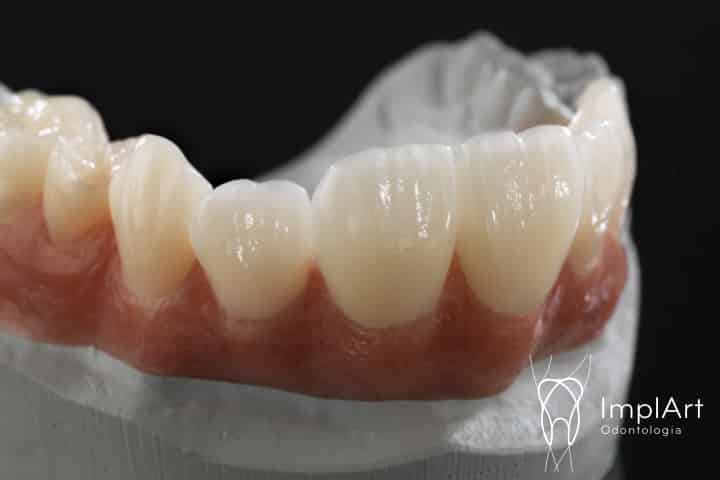
Durability of dental cubic zirconia
Dental zirconia-based crowns have performed just as well over 5 years as metal-based crowns, according to a scientific study. Those made of zirconia, called monolithic zirconia crowns, are especially durable.
All the porcelain crowns described can be made for cemented or screw-retained dental prostheses on dental implants.
Biocompatibility of dental zirconias
Zirconia is the choice of many dentists because of its biocompatibility, which means that the body is less likely to provoke a reaction or immune response such as inflammation. Zirconia is such a biocompatible material that there are white zirconia dental implants. There is a current today of more natural biological dentistry, which advocates the use of more biocompatible and metal-free materials, and the pure zirconia dental crown fits the bill perfectly. It is therefore important for you to know that there is currently the possibility of carrying out a ceramic dental implant treatment, without metal, and combining it with a Pure Zirconia or Pure Porcelain dental crown, thus obtaining a metal-free treatment!
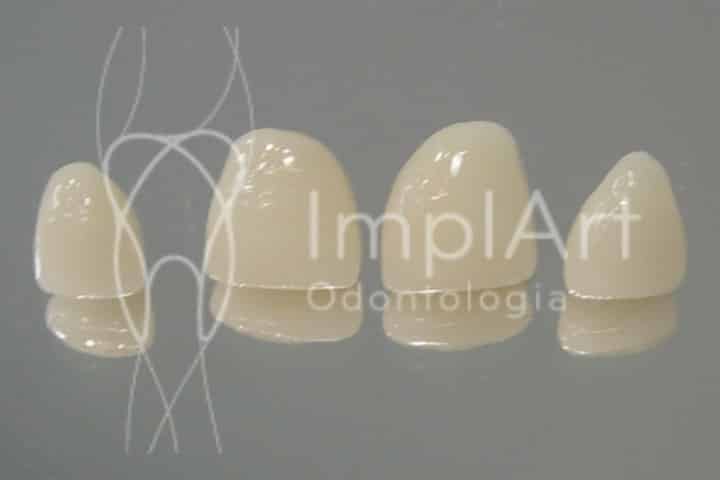
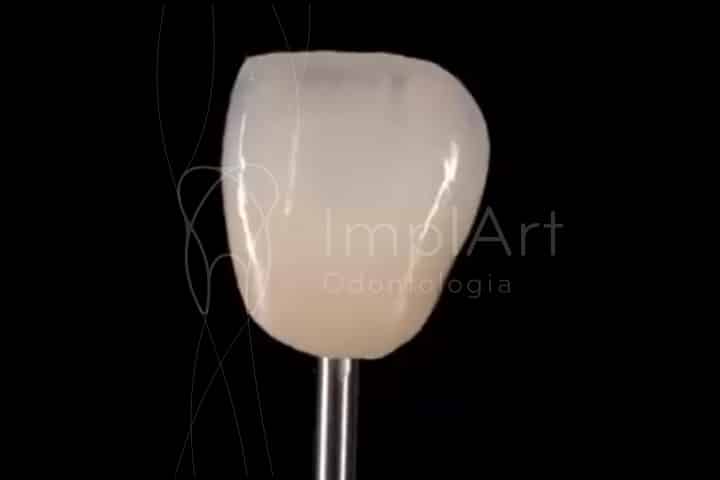
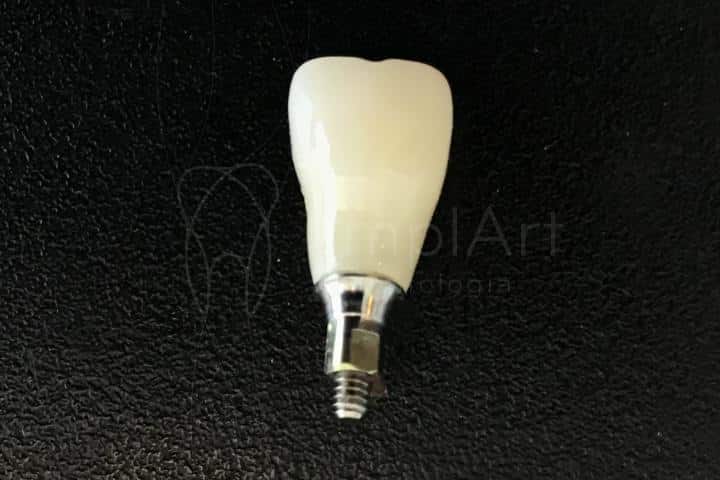
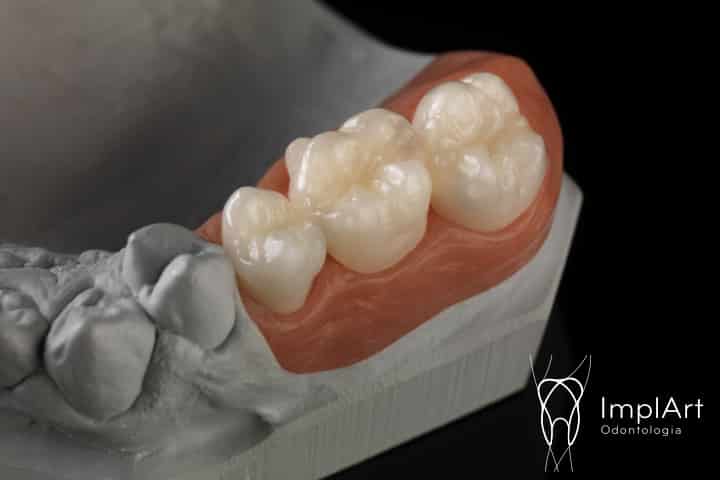
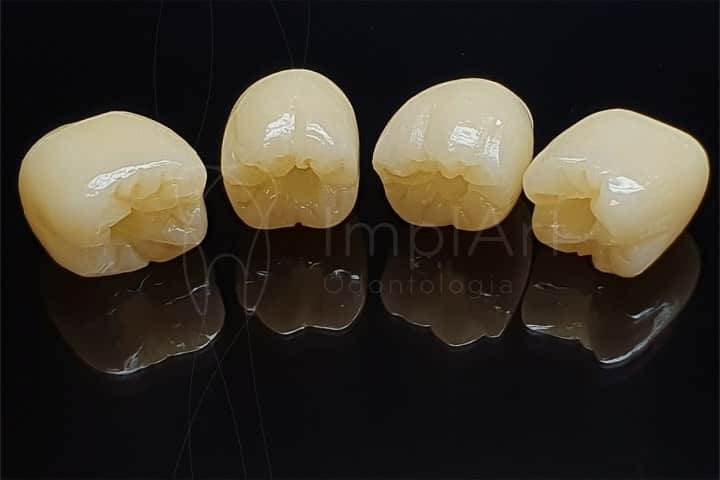
Discover our complete structure – in the Avenida Paulista area/ Downtown São Paulo-Brazil
Here at the ImplArt Dental Clinic, all prostheses, crowns and restorations are made in our own prosthetics laboratory using computerized systems. With computerized dental crowns, which can be used in any area of the mouth, the appearance, shape and alignment of the teeth are improved, as well as their strength, which also benefits.
If you have any questions, please contact us, visit our photo gallery or book an appointment with our team📲WhatsApp(11) 3262-4750. We’d be delighted to hear from you!
Learn all about the types of dental crowns – read the main topics
Dr. Roberto Markarian, implant dentist
Text written by DR. ROBERTO MARKARIAN – CRO-SP 73.583
Founder and Director of the ImplArt Dental Clinic – Dr. Roberto’s Linkedin profile
Dr. Roberto Markarian is one of the leading specialists in dental implants and computerized prostheses in Brazil, with more than 10,000 implants performed. In addition to his vast clinical experience, he is a renowned researcher, contributing to dentistry with publications in international scientific journals. At the ImplArt Clinic, Dr. Roberto applies high technology to all his treatments, offering patients innovative solutions and superior quality.
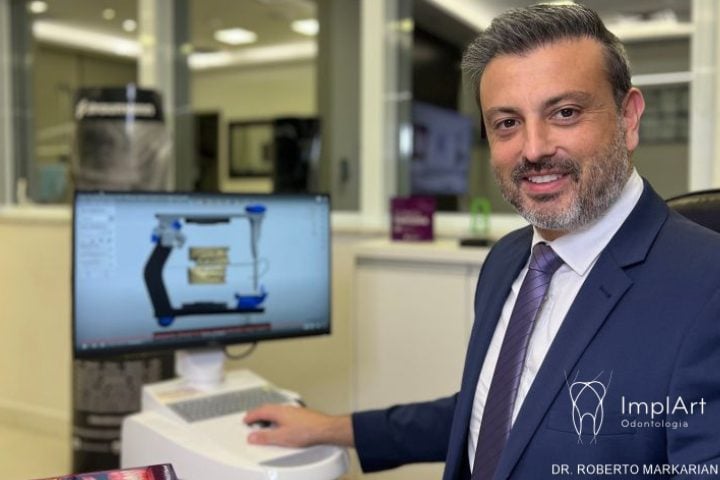
 Agende sua consulta agora por WhatsApp
Agende sua consulta agora por WhatsApp
Leave a Reply